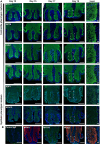Regional differences in three-dimensional fiber organization, smooth muscle cell phenotype, and contractility in the pregnant mouse cervix
- PMID: 39693423
- PMCID: PMC11654679
- DOI: 10.1126/sciadv.adr3530
Regional differences in three-dimensional fiber organization, smooth muscle cell phenotype, and contractility in the pregnant mouse cervix
Abstract
The orientation and function of smooth muscle in the cervix may contribute to the important biomechanical properties that change during pregnancy. Thus, this study examined the three-dimensional structure, smooth muscle phenotype, and mechanical and contractile functions of the upper and lower cervix of nongravid (not pregnant) and gravid (pregnant) mice. In gravid cervix, we uncovered region-specific changes in the structure and organization of fiber tracts. We also detected a greater proportion of contractile smooth muscle cells (SMCs), but an equal proportion of synthetic SMCs, in the upper versus lower cervix. Furthermore, we revealed that the lower cervix had infrequent spontaneous contractions, distension had a minimal effect on contractility, and the upper cervix had forceful contractions in response to labor-inducing agents (oxytocin and prostaglandin E2). These findings identify regional differences in cervix contractility related to contractile SMC content and fiber organization, which could be targeted with diagnostic technologies and for therapeutic intervention.
Figures







Similar articles
-
Preoperative ripening of the cervix before operative hysteroscopy.Cochrane Database Syst Rev. 2015 Apr 23;2015(4):CD005998. doi: 10.1002/14651858.CD005998.pub2. Cochrane Database Syst Rev. 2015. PMID: 25906113 Free PMC article.
-
Discontinuation of intravenous oxytocin in the active phase of induced labour.Cochrane Database Syst Rev. 2018 Aug 20;8(8):CD012274. doi: 10.1002/14651858.CD012274.pub2. Cochrane Database Syst Rev. 2018. PMID: 30125998 Free PMC article.
-
Novel Directly Reprogrammed Smooth Muscle Cells Promote Vascular Regeneration as Microvascular Mural Cells.Circulation. 2025 Apr 15;151(15):1076-1094. doi: 10.1161/CIRCULATIONAHA.124.070217. Epub 2025 Feb 13. Circulation. 2025. PMID: 39945059
-
Oxytocin antagonists for assisted reproduction.Cochrane Database Syst Rev. 2021 Sep 1;9(9):CD012375. doi: 10.1002/14651858.CD012375.pub2. Cochrane Database Syst Rev. 2021. PMID: 34467530 Free PMC article.
-
Smooth Muscle Cell-Derived Fibronectin Promotes an Atheroprotective Smooth Muscle Cell Phenotype Associated With Altered NO-cGMP Signaling.J Am Heart Assoc. 2025 Jun 3;14(11):e040395. doi: 10.1161/JAHA.124.040395. Epub 2025 May 29. J Am Heart Assoc. 2025. PMID: 40439151 Free PMC article.
References
-
- Yu S. Y., Tozzi C. A., Babiarz J., Leppert P. C., Collagen changes in rat cervix in pregnancy-polarized light microscopic and electron microscopic studies. Proc. Soc. Exp. Biol. Med. 209, 360–368 (1995). - PubMed
-
- Leppert P. C., Cerreta J. M., Mandl I., Orientation of elastic fibers in the human cervix. Am. J. Obstet. Gynecol. 155, 219–224 (1986). - PubMed
-
- Barnum C. E., Shetye S. S., Fazelinia H., Garcia B. A., Fang S., Alzamora M., Li H., Brown L. M., Tang C., Myers K., Wapner R., Soslowsky L. J., Vink J. Y., The non-pregnant and pregnant human cervix: A systematic proteomic analysis. Reprod. Sci. 29, 1542–1559 (2022). - PubMed
MeSH terms
Grants and funding
LinkOut - more resources
Full Text Sources
Medical

